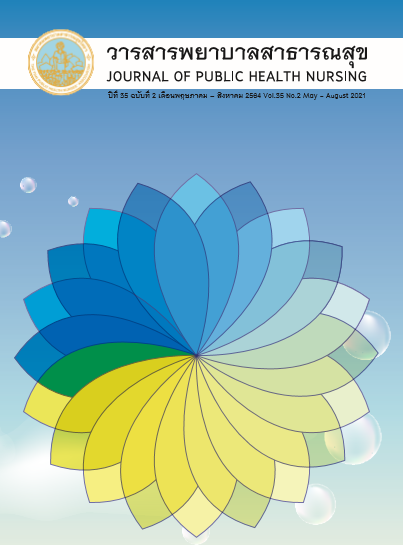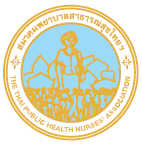Pitfalls of Nursing Care in Head Injury Patients with Increased Intracranial Pressure
Keywords:
Pitfalls, Nursing, Head Injury, Increased intracranial pressureAbstract
Wearing a fabric hygienic or cloth mask can be used to prevent the spread of the coronavirus 2019 in situations where surgical masks are scarce. This descriptive research aimed to study the factors related to cloth mask utilization behavior in COVID-19 prevention of peoples in Pathumthani Province. The study samples consisted of 315 people. Data were collected using 3 questionnaires; the demographic data record form, cloth mask behavior, and Cognitive-Perceptual factors of Pender’s health promotion model (HPM); perceived benefit, perceived barriers, self-efficacy, interpersonal influence, and situational influence. The content validity test was at 1.00, and the reliability test was conducted using Cronbach’s alpha coefficient at .80 and .85. Statistics used for data analysis consisted of Spearman’s s Correlation and Pearson’s Product Moment Correlation coefficient.
The study results showed that education level and cognitive-perceptual factors including perceived benefit and situational influence were statistically significant related to cloth mask utilization behavior (r = -.157, .366 and .216 consecutively).
The study results should be used as a guideline to promote the perception of benefits and the correct information of situation for cloth masks using to prevent infection.
References
Transport Accident Management Systems (TRAMS). Accident situation on the network of the Ministry of Transport [Internet]. Ministry of Transport; 2021 [cited 2021 May 11]. Available from: https://trams.mot.go.th/report-executive.
Burton J. Countries with the most car accidents [Internet]. WorldAtlas; 2018 [cited 2021 May 11]. Available from: https://www.worldatlas.com/articles/the-countries-with-the-most-car-accidents.html.
Phuenpathom N, Srivilaikul T, editors. Clinical practice guidline for traumatic brain injury. Bangkok: Prosperous Plus; 2020.
Zerfoss CL. Reducing intracranial pressure in patients with traumatic brain injury. Am Nurse Today 2016; 11(10): 1-6.
Smith N. Intracranial Pressure Patient. Ipswich, Massachusetts: EBSCO Publishing; 2017.
Pasukunthapuk N, Piyopasakul W, editors. Clinical Nursing Practice Guidelines for patient with craniotomy. Bangkok: Thanaplace; 2014.
Thungjaroenkul P. Systematic Management for Patient Safety Achievement. Nursing Journal 2018; 45(2): 148-56. (in Thai)
Reason J. Human error: models and management. British Medical Journal 2000; 320(7237): 768-70.
Suwanpitak W, Vipavakarn S, Prakeetavatin B. Development to clinical nursing practice guideline for patients with mild traumatic brain injury in Krabi hospital. The Southern College Network Journal of Nursing and Public Health 2017; 4(2): 140-56. (in Thai)
Kirkman MA, Smith M. Intracranial pressure monitoring, cerebral perfusion pressure estimation, and ICP/CPP-guided therapy: a standard of care or optional extra after brain injury? British Journal of Anaesthesia 2014; 112(1): 35-46.
Prachuablarp C. Increased intracranial pressure in patients with brain pathology: A dimension of evidence-base nursing practice. Thai Journal of Nursing Council 2018; 33(4): 15-28. (in Thai)
Diringer M. Neurologic manifestations of major electrolyte abnormalities. Handb Clin Neurol 2017; 141: 705-13.
John CA, Day MW. Central Neurogenic Diabetes Insipidus, Syndrome of Inappropriate Secretion of Antidiuretic Hormone, and Cerebral Salt-Wasting Syndrome in Traumatic Brain Injury. Critical Care Nurse 2012; 32(2): e1-8.
Smith N, Gilreath-Osoff. Syndrome of Inappropriate Antidiuretic Hormone Secretion (SIADH). Ipswich, Massachusetts: EBSCO Publishing; 2018.
Vyas K, Singh KM. Outcome of Cranioplasty Done within and Beyond 2 Months after Decompressive Craniectomy for Traumatic Brain Injury. Journal of Evolution of Medical and Dental Sciences 2021; 10(10): 711-5.
Unda SR, Mousa H, Labagnara K, Birnbaum J, de Silva N, Wong M, et al. Gram-Negative Ventriculostomy-Associated Infections Predict Shunt Dependency in Stroke Diagnoses and Other Brain Injuries. Operative neurosurgery (Hagerstown, Md) 2021; 20(5): 462-8.
Sevdi MS, Demirgan S, Erkalp K, Akyol O, Ozcan FG, Guneyli HC, et al. Continuous Endotracheal Tube Cuff Pressure Control Decreases Incidence of Ventilator-Associated Pneumonia in Patients with Traumatic Brain Injury. Journal of Investigative Surgery 2021: 1-15. doi.org/10.1080/08941939.2021.1881190.
Sabet N, Soltani Z, Khaksari M. Multipotential and systemic effects of traumatic brain injury. Journal of Neuroimmunology 2021; 357: 1-14.
Rukyingcharean K, Thaikla A, Suvarnakuta P. Use of ABCs mnemonic concept in caring for patients with increased intracranial pressure. Journal of Health Science Research 2018; 12(Suppl): 12-9. (in Thai)
Wonganan U. Reducing Body Temperature in Patients with Traumatic Brain Injury, Presenting with Fever. APHEIT Journal 2015; 4(2): 75-82.
Ponglaohapun U, Wongwatunyu S, Khuwatsamrit K. Nursing Activities and Factors Related to Increased Intracranial Pressure in Head Injured Patients. Ramathibodi Nursing Journal 2009; 15(2): 221-32. (in Thai)
Thapsongsang P, Yodrak W. Endotracheal suctioning in patients with severe traumatic brain injury. Songklanagarind Journal of Nursing 2018; 38(3): 192-7. (in Thai)
Khiewchaum R, Wattana C. Holistic nursing of traumatic brain injury patient. Journal of Phrapokklao Nursing College 2017; 28(1): 129-39. (in Thai)
Piyahiran J. A call for knowledge and skill of caregivers for stroke patients during the covid-19 pandemic. Journal of Public Health Nursing 2020; 34(3): 152-63. (in Thai)
Abdulle AE, de Koning ME, van der Horn HJ, Scheenen ME, Roks G, Hageman G, et al. Early Predictors for Long-Term Functional Outcome after Mild Traumatic Brain Injury in Frail Elderly Patients. J Head Trauma Rehabil 2018; 33(6): e59-67.
Emeot Y. Rehabilitation post concussion syndrome in mild traumatic brain injury: Nurse’s role. Journal of Nursing Division 2020; 47(1): 1-10. (in Thai)
Komonsuradej N. Patient safety in ambulatory care. Binla Book; 2018 [cited 2021 Aug 16]. Available from: https://meded.psu.ac.th/binla/class04/388_441/patient_safety_in_ambulatory_care/index3.html
Downloads
Published
How to Cite
Issue
Section
License
บทความที่ตีพิมพ์และแผนภูมิรูปภาพถือเป็นลิขสิทธิ์ของวารสารพยาบาลสาธารณสุข (Thai Public Health Nurses Association)







